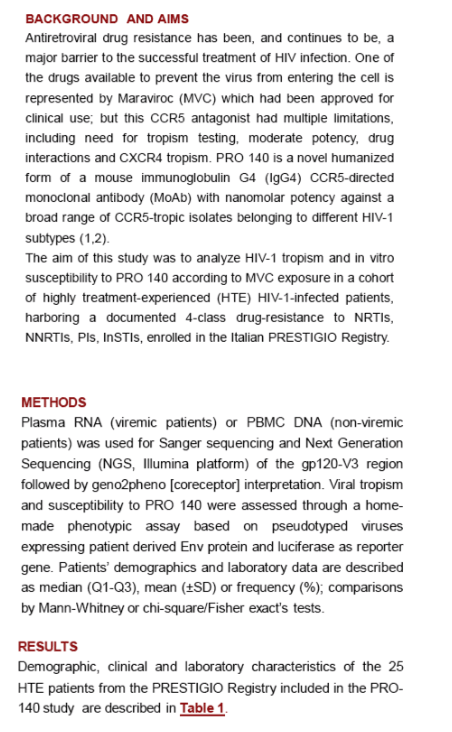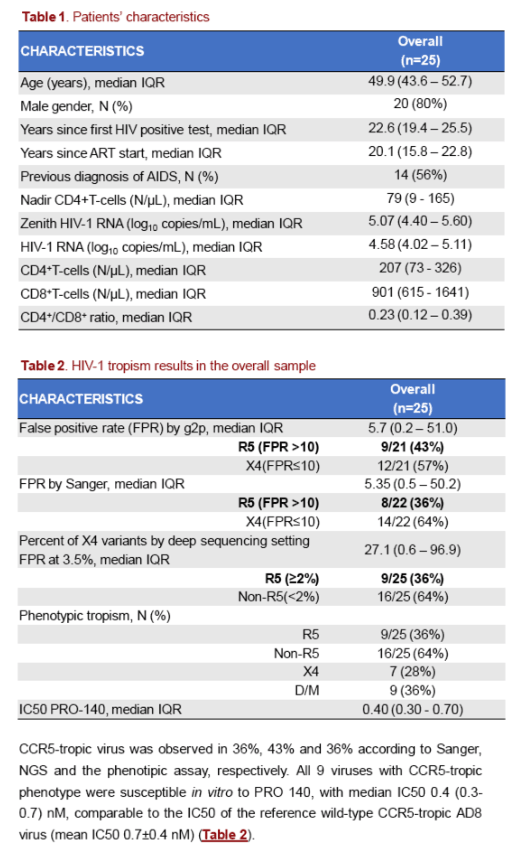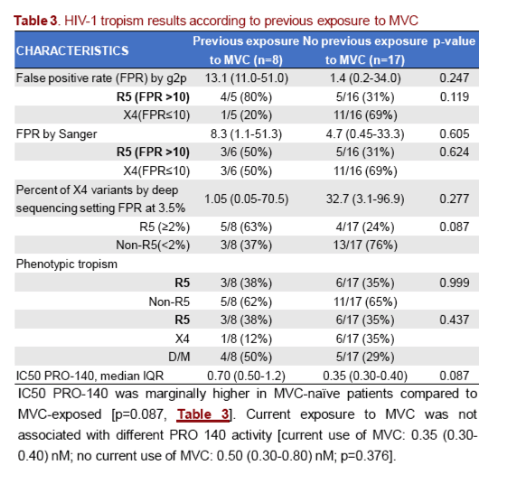 |
 |
 |
| |
PRO 140 IN VITRO ACTIVITY IN HTE SUBJECTS WITH A
4-CLASS DRUG-RESISTANT HIV-1 VIRUS
|
| |
| |
CROI 2020
Reported by Jules Levin
Stefano Rusconi1 , Francesco Saladini2, Silvia Barbaliscia3 , Andrea Poli4 , Laura Galli4 , Roberta Gagliardini5 , Lidia Gazzola6 , Daniela Francisci 7, Francesca Vichi8 , Emanuele Focà9 ,
Maurizio Zazzi2 , Maria M. Santoro3 , Arianna Gabrieli1 , Antonella Castagna4 , for the PRESTIGIO Registry study group
1University of Milan, Milan, Italy;2 University of Siena, Siena, Italy; 3University of Rome Tor Vergata, Rome, Italy; 4San Raffaele Vita-Salute University, Milan, Italy; 5Lazzaro Spallanzani National Institute for Infectious Diseases, Rome, Italy; 6Azienda Ospedaliera San Paolo, Milan, Italy; 7University of Perugia,
Perugia, Italy, 8Santa Maria Annunziata Hospital, Florence, Italy,; 9University of Brescia, Brescia, Italy

Abstract
PRO 140 is a novel humanized form of a mouse immunoglobulin G4 CCR5-directed monoclonal antibody with nanomolar potency in inhibiting HIV-1 cell entry through the CCR5 coreceptor. The aim of this study was to analyze HIV-1 tropism and in vitro susceptibility to PRO 140 according to MVC exposure in a cohort of heavily treatment-experienced (HTE) HIV-1-infected patients (pts) harboring a documented 4-class drug-resistance to NRTIs, NNRTIs, PIs, InSTIs, enrolled in the Italian PRESTIGIO Registry.
Plasma RNA (viremic pts) or PBMC DNA (non-viremic pts) was used for Sanger sequencing and Next Generation Sequencing (NGS, Illumina platform) of the gp120-V3 region followed by geno2pheno [coreceptor] interpretation. Viral tropism and susceptibility to PRO 140 were assessed through a home-made phenotypic assay based on pseudotyped viruses expressing patient derived Env protein and luciferase as reporter gene. Pts demographics and laboratory data are described as median (Q1-Q3), mean (±SD) or frequency (%).
Among 25 pts, 20 (80%) were male, median age 50 years (44-53), time since HIV-1 diagnosis 23 years (19-26), time on ART 20 years (16-23), 14 (56%) with a previous AIDS diagnosis, 17 (68%) with maraviroc (MVC) exposure, a median CD4+ count 207 cells/l (73-326) and a median viral load 4.58 log10 copies/mL (4.02-5.11), with 2 pts with HIV-RNA<40 copies/mL. CCR5-tropic virus was observed in 36%, 43%, 36% accordingly to Sanger, NGS and the phenotypic assay; the overall concordance among the three methods was 65% while pairwise agreement ranged from 76% (NGS vs phenotypic assay) to 86% (Sanger vs phenotypic assay). All 9 viruses with CCR5-tropic phenotype were susceptible in vitro to PRO 140, with median IC50 0.4 (0.3-0.7) nM, comparable to the IC50 of the reference wild-type CCR5-tropic AD8 virus (mean IC50 0.70.4 nM). There was a variation between MVC-nave (n=3; median IC50=0.70, IQR=0.50-1.2 nM) and MVC-exposed (n=6; median IC50=0.35, IQR=0.30-0.40 nM) pts (p=0.087 [Wilcoxon rank-sum test]) (Table 1). Current exposure to MVC was not associated with different PRO 140 activity (p=0.376).
In this group of HTE pts with MDR virus, all CCR5-tropic strains were fully susceptible to PRO 140 and they were not significantly impacted by MVC exposure. PRO 140 can thus play a key role in subjects with very limited therapeutic options and CCR5-tropic virus.



|
| |
|
 |
 |
|
|